SOUTH AFRICA
Plants and Animals

Plants and Animals

Cities in SOUTH AFRICA
| Cape town | Johannesburg |
Plants and Animals
Plants
About 10% of all known plant species can be found in southern Africa: approximately 24,000 species. Well-known plants originally from South Africa include geranium, rocket, freesia, tuber rose and gladiolus.
Due to the large differences in precipitation, from east to west increasingly drier, and the distribution of that precipitation over the year, the plant growth in South Africa varies greatly. Soil conditions and height differences naturally also play a major role.
The fine forest region or the Cape Vegetable Kingdom in the southwest is the most remarkable region of South Africa in terms of the plant world. Thousands of endemic species occur here, so species that only occur here and nowhere else in the world. The area is surrounded by the ocean, deserts and mountains and is one of the six official flora kingdoms in the world and is also called "Capensis". Flora rich are areas where the flora is very different from plants found elsewhere. There are 2500 different native species on the Cape Peninsula alone. In this area there are about 600 heather species of a particular family (against 26 species in the rest of the world!) And the most famous orchid of South Africa, the "Pride of Table Mountain" or in English "pride of Table Mountain".
This is also the land of the Protea or sugar forest. The king protea is the national flower of South Africa with flowers of 25 centimeters in diameter.
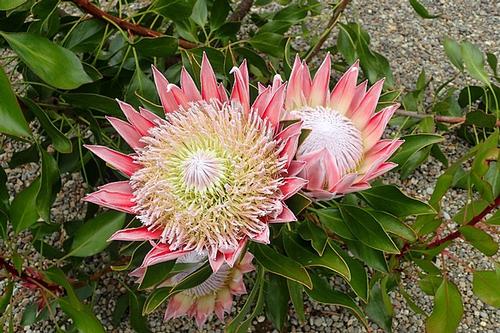 King or giant protea, national flower of South AfricaPhoto: Krzysztof Ziarnek, Kenraiz, CC 4.0 International no changes made
King or giant protea, national flower of South AfricaPhoto: Krzysztof Ziarnek, Kenraiz, CC 4.0 International no changes made
Famous are the millions of marigolds that decorate Namaqualand in the Namid Desert in the North Cape Province in the spring. The fine forest also has 1000 varieties of daisies, 600 varieties of irises and 400 varieties of lilies.
The rest of South Africa consists of savannahs, steppes, grasslands and deserts, each with their own vegetation. Only half a percent of the total area consists of forests. Despite that, there are still about 1000 tree species in South Africa. An important forest area is located in the far south around Knysna, west of Port Elizabeth. These evergreen forests include 50-meter-high Podocarpus species or "yellow-tree" (conifers that are almost exclusively found in the southern hemisphere), Cape beech and Olea laurifolia, an olive tree species.
In the area of slightly higher up East London, mangroves are found alongside palms, wild bananas and milk trees. In the east there is a subtropical forest with, of course, palm species and Albizzia species, a plant genus from the mimosa family. Due to the subtropical climate, many types of flowers occur on the east coast, including hibiscus, rhododendron, azalea and golden rain.
Due to the high humidity and a lot of rainfall, we find mountain forests on the eastern slopes of the Drakensberg. The national tree of South Africa is the yellowwood (Podocarpus Latifolius).
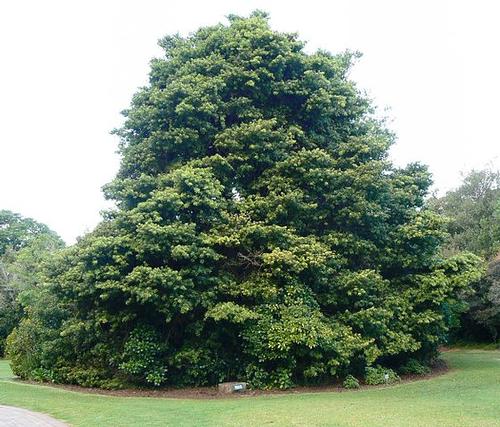 Broad-leaved yellowwood or real yellowwood, national tree of South-AfricaPhoto: Abu Shawka in the public domain
Broad-leaved yellowwood or real yellowwood, national tree of South-AfricaPhoto: Abu Shawka in the public domain
Grasslands, with 1,000 native grasses, and savannas are found in areas with summer rainfall, except for the grassy savannas in the southeast where spring and autumn rains occur. All kinds of transitions occur on the savannas, for example to woody grasslands, park landscapes and to tree steps with scattered trees. Characteristic of these landscapes are acacia species and spurge and aloe species in the drier areas. Common grasses include Themeda, Chloris, millet grass, Setaria, Pennisetum and Rhynchelytrum. We also find here the baobab or monkey bread tree, the bark tree and the elephant tree.
Another important flora region is the Namu-Karroo on the central plateau. Here it rains very little, we mainly find low shrubs and grasses. Well-known varieties are kassia wood, kapok bushes, tea bushes, feather grass and ostrich grass. The Catalpa shrub or catalpa can grow to over two meters in height.
Steppe-like deserts (including the Kalahari) are found especially in the western parts of South Africa, where there is little rainfall. In the semi-desert of the Great Karroo (Hottentots for dry or scarce) grow up to 2 m high dwarf shrubs with scaly leaves, and many species of the succulent genus Mesembryanthemum. Large numbers of ice plants and pebble plants are also found here. These plants bloom for a short time in September and October.
Where precipitation is somewhat higher, Pentzia species are characteristic and trees such as the Aloe arborescens are found. Welwitschia mirabilis is a special species in the western desert areas. It is the only surviving species of an extinct family. It resembles a giant root with two leathery, frayed leaves "crawling" on the ground.
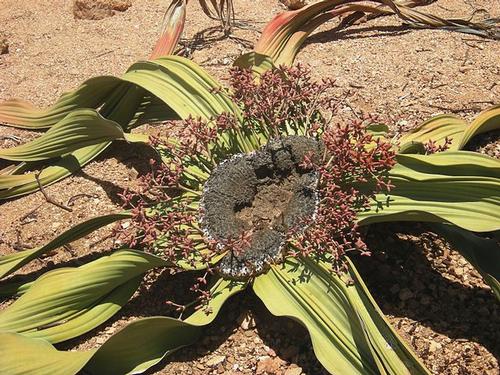 Welwitschia mirabilis, South AfricaPhoto: Franzfoto CC 3.0 Unported no changes made
Welwitschia mirabilis, South AfricaPhoto: Franzfoto CC 3.0 Unported no changes made
Animals
Mammals
In total there are about 400 species of mammals in South Africa with the animals that are characteristic of Africa as a continent, such as lion, panther, hyena, zebra, monkey, rhinoceros, buffalo, wildebeest or wildebeest, giraffe, elephant, antelope, cliff, hippo, warthog, baboon (or bobbejaan) and many more.
Springbok, the national animal of South Africa, blesbok (with the subspecies bontebok), white-tailed wildebeest, buck-antelope, mountain zebra, meerkat, black-footed cat, etc. are exclusively found in Southern Africa. Other species also occur elsewhere in the world, but have a clearly recognizable isolated shape in South Africa, such as the skewer (oryx) and the dik-dik.
The Quagga, Cape Lion, Cape Warthog and the Bluebuck were extirpated long ago and only occurred in the Cape Province. Many endemic (= only occurring in South Africa) forms are known among the smaller mammals; for example the gold moles.
There are five monkey or primate species in South Africa: baboon, gray meerkat, green meerkat and the small and large galago, both nocturnal animals that always live in trees and are actually half-monkeys.
Of the predators, the "king of animals", the lion, is of course the best known. Formerly common, poaching limits their territory to the lowlands of Eastern Transvaal, Northern Natal and the northern part of the Cape Province. The rare white lions are found in the private game reserve Timbivati Game Reserve. The panther and cheetah are other large feline predators. Cheetahs are mainly found in the Kruger Park and the Kalahari Gemsbok Park.
Hyena dogs or African wild dogs and the spotted hyena are besides scavengers also predators that hunt other animals in groups. The brown hyena, on the other hand, is a real scavenger. Other small meat eaters are the jackal, the caracal and the serval.
The many termite mounds and ant heaps are regularly visited by aardwolves, aardvarks and ground pangolins or pangolins.
The African elephant living in herds can reach a height of three meters and is therefore considerably larger and heavier than the Indian elephant. In the Addo Elephant National Park we managed to protect the Cape elephant from extinction. There are two types of rhinoceros in Southern Africa: the white or broad-lipped rhinoceros and the black or pointed-lipped rhinoceros. The broad-lipped rhinoceros was almost extinct in the early 20th century, but due to protective measures and a special breeding program, the number has grown again. Both the tusks of the elephants and the horns of the rhinoceros are highly sought after by poachers. Another pachyderm is the hippopotamus, a herbivore that spends most of its time in the water.
The two wild pig species in South Africa are the brush pig and the warthog with its warty head and large curved tusks.
The most famous ungulate animal in Africa is of course the black and white striped zebra. In South Africa the common or steppe zebra and the endangered mountain zebra occur, which is protected in the National Mountain Zebra Park near Cradock in the Eastern Cape. The giraffe is an imposing appearance that can grow up to six meters high.
Bovine animals include antelopes and cattle. There are 38 species of antelope in South Africa, including the great kudu, the impala, the spiesbok, the ibex, the common diver, the sable, the horse antelope and the springbok, which have been chosen as the symbol and national emblem of South African sports teams. Special species are the gray buck, the nyala and the oribi.
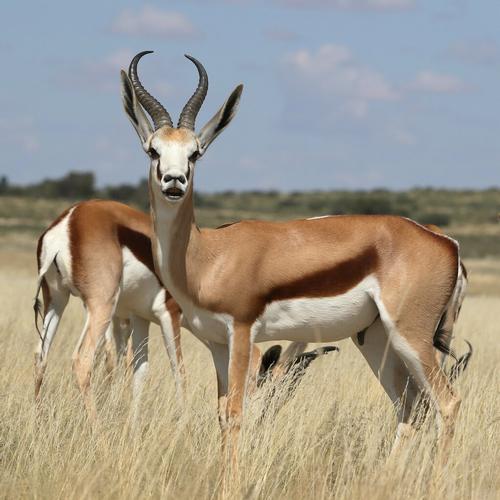 Springbok, national emblem of South African sports teamsPhoto: Derek Keats from Johannesburg, South Africa CC 2.0 Generic no changes made
Springbok, national emblem of South African sports teamsPhoto: Derek Keats from Johannesburg, South Africa CC 2.0 Generic no changes made
Cattle include the African buffalo that even lions walk around with a large arch.
Many of the smaller mammals live in the air or underground. About 75 species of bats are found in South Africa. Most species are insectivores, and eight species feed on nectar and fruits.
South Africa's largest rodent is the South African porcupine and most notable to see is the jumping hare jumping through the grounds like a kangaroo. The large reed rat is considered a delicacy by some local populations and can weigh between 4 and 7 pounds. The rock cliff or "dassie" looks like a rodent but is closely related to the elephant!
Groups of bottlenose dolphins, a type of dolphin, can often be seen off the coast. The number of sperm whales has increased again due to protective measures. Another species of whale, the giant blue whale, can be seen occasionally on the coast.
Birds
The bird world of South Africa is even richer than that of the mammals and includes about 870 species. It must be said that a large part of this consists of migratory birds that hibernate in South Africa, such as the stork and the barn swallow.
Large raptors such as the steppe eagle and the tufted eagle are found in the eastern forest areas. What is smaller is the bateleur or magic eagle, which is so called because of its antics in the air. The large fig trees that grow here are home to many birds, including the turaco, the green pigeon, the hornbill, the bearded bird, the bulbul and the colorful bee-eaters.
Many kingfishers are also found in the forests and along the major rivers. The African kingfisher and the pied kingfishers live along the rivers, the African dwarf kingfisher and the gray-headed kingfisher in the forests.
One of the most beautiful birds in this area is the fork-tailed hawk. The yellow-billed and red-billed toad, hornbills, are very remarkable birds and the southern hornbill is also very striking. The horned raven is a ground hornbill and eats insects, reptiles and other small animals. The hermit cuckoo or "piet-my-vrou" has a very characteristic song.
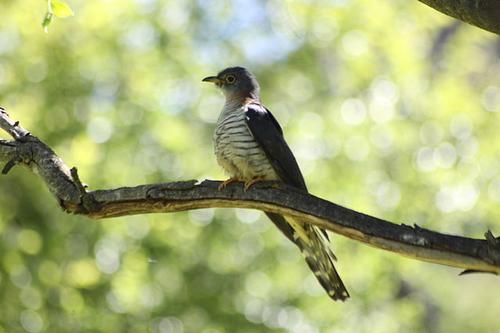 Red-chested cuckoo, South AfricaPhoto: Derek Keats from Johannesburg, South Africa CC 2.0 Generic no changes made
Red-chested cuckoo, South AfricaPhoto: Derek Keats from Johannesburg, South Africa CC 2.0 Generic no changes made
On the Hoogveld, the open grass plains of Transvaal and Free State, you can see the rare blue bust or Korhaan and also the Kori bust. Both birds and quail and frankolines are hunted for their meat. A beautiful bird is the cocks-tail widow finch and beautiful to see are the herons that often piggyback with large animals and thus get their food. The large secretary bird also lives here, sometimes in a battle with snakes, which he tries to kill. Endemic to this area are the Cape Rock Springer and the very remarkable Cape Woodpecker, which lives on the ground and feeds on ants.
The forests, slopes and valleys of KwaZulu / Natal have a rich bird life. Here you will find forest weavers, honey suckers, flycatchers, the emerald cuckoo, the purple crested turaco and the endemic black hood optimism. Gray-winged fringes, yellow-breasted pipits live on grassy slopes and Gurney's sugar bird is found near proteas.
The national bird of South Africa is the Stanley or blue crane.
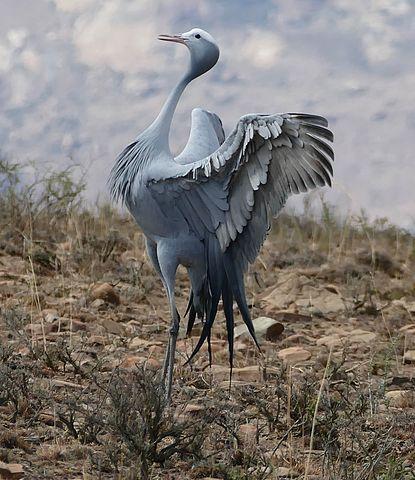 Blue crane, national bird of South AfricaPhoto: Derek Keats from Johannesburg, South Africa CC 2.0 Generic no changes made
Blue crane, national bird of South AfricaPhoto: Derek Keats from Johannesburg, South Africa CC 2.0 Generic no changes made
Bearded vultures, Cape vultures and black eagles search for prey or bait from great heights. The crowned eagle attacks monkeys and small antelopes from trees. Game Valley near Pietermaritzburg is home to more than 300 bird species including kingfishers, wagtails, guinea fowl, hammerhead, long claws, grass warblers, trogons and shrike shrubs.
Along the northeast coast, herons, geese, white pelicans and flamingos find an ideal habitat, as does the majestic African fish eagle. Adjacent to Mozambique in the Ndumo Game Reserve, subtropical environments are home to species such as Pel's fishing owl, brown popnicator, crested guinea fowl and purple-banded honey sucker. Different species of storks, herons (including black heron), bitterns, night herons and even the rare water trapper or African grebe coot live here.
In the Karoo and the Dry Western Areas, the most notable birds are the Black Chinstrap or Karoo Korhaan and the Ludwigs Bustard. The thrush flycatcher, the red-ear prinia and the Layards titmouse are also special. A number of endemic lark species live in the far west: the red desert lark and the Namaqua lark. The most famous bird from this region in the ostrich, of course, the largest bird in the world that can grow up to about 2.5 meters high. In the Kalahari Desert, the enormous nests of Republican weavers are striking, which can measure up to four meters in diameter and house up to 200 birds. The smallest bird of prey in Africa, the African pygmy falcon, often lives in these nests. The sandgrouse occurs at watering holes, which carries water in its belly feathers to give to the chicks.
The fine forest area (mostly low shrubs with small leaves) is home to two endemic species that live on nectar, the Cape sugar bird and the orange breast honey piston. Also endemic are the white-winged canary and the Victorins bush warbler, seed eater and insect eater respectively. The warbler and elf apalis are found in the drier parts of the fine forest.
The colder south and west coasts due to the cold Benguela Gulf Stream attract many seabirds. Special is the black-footed penguin or "pike wine" which breeds in colonies on islands off the coast. We also see large groups of cormorants, kelp gulls and Cape gannets, black oystercatchers and griffon plovers.
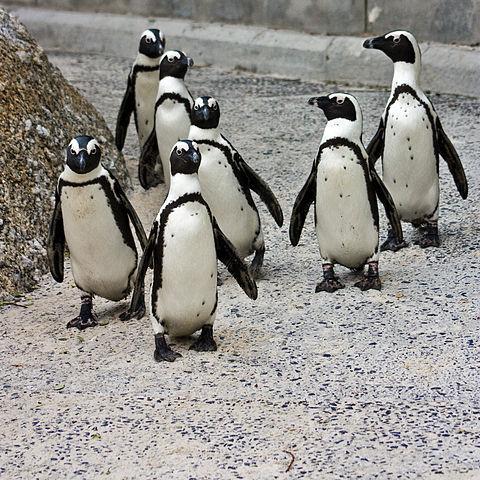 African, Cape or South African penguinPhoto: Freestock.ca CC 3.0 Unported License no changes made
African, Cape or South African penguinPhoto: Freestock.ca CC 3.0 Unported License no changes made
More than a hundred bird species migrate from the Northern Hemisphere to the coasts of South Africa every year. Distances of up to 10,000 kilometers are sometimes covered for five to seven weeks. Most migratory birds are sandpipers.
Amphibians and reptiles
The number of amphibians and reptiles is also very high in South Africa and new species are still being discovered and described. Again some special species such as the primitive, tongueless clawed frog, the narrow-mouthed frogs that only emerge after a rain shower and the endemic South African bull frog. Salamanders occur below the Sahara, and therefore not in South Africa either. The Nile crocodile is only found in reserves.
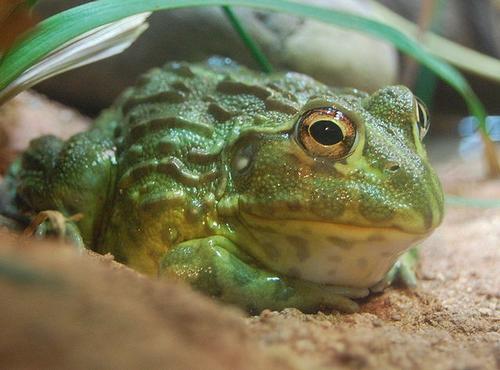 African bullfrog, South AfricaPhoto: Steven G. Johnson CC 3.0 Unported no changes made
African bullfrog, South AfricaPhoto: Steven G. Johnson CC 3.0 Unported no changes made
The number of turtle species is very large: five species of sea turtles, five freshwater African neckwicks (neckwicks retract their necks in an S-shape; neckworms retract head and neck right under the shell) and twelve species of tortoises, more than anywhere else in the world. The geometric tortoise is the smallest with a length of only 10 centimeters. Red-eared sliders are common but have been imported from North America.
The many gecko species, including the house gecko, devour enormous numbers of insects and are therefore very useful. The Namaqua chameleon is notable for living on the ground. Native reptiles are the girdle-tailed lizards to which the armored girdle-tailed lizard belongs, agames, South African keel lizards, rock lizards and keel scale lizards. The largest African lizard is the Nile monitor, which can grow up to two meters long.
There are also 130 snake species. In addition to the dangerous rock python, a strangling snake, there are 14 species of venomous snakes. These include the black-necked cobra, mambas and the puff adder. The African egg snake is harmless.
Insects
South Africa is an Eldorado for entomologists with about 50,000 species. The tropical forest field savannas in the north are home to many species. Giant termites, stick insects, many butterfly species (approx. 800 species of butterflies) and scarab beetles, praying mantis are the most striking species.
Separate is also the Matabele Ant that plunder termite mounds. There are many tropical forms on the east coast, such as beautifully colored cockchafer and beautiful tropical butterflies, such as a large number from the Nymphalidae family.
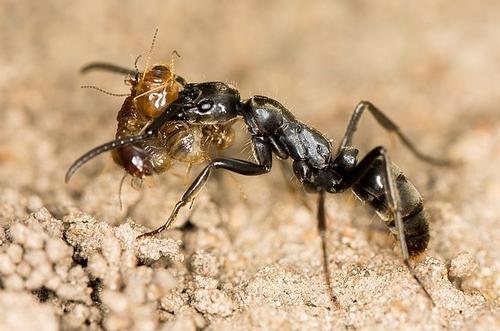 Matabele ant, South AfricaPhoto: ETF89 CC 4.0 International no changes made
Matabele ant, South AfricaPhoto: ETF89 CC 4.0 International no changes made
Very strange boarders occur in the Cape region. Famous are the rare wingless beetles that belong to the flying deer family. The national flower of South Africa, the protea, attracts rose beetles (approx. 200 species), cockchafer and golden beetles.
Game Reserves
Outside the reserves, there is still little game to be found. Nature conservation started early with the Umfolosi / Hluhluwewildreserves in 1897 as the predecessor of the internationally famous Kruger National Park in 1898. The Kruger Park is about the same size as half of the Netherlands and is visited by more than 700,000 tourists every year.
Currently, there is a network of 17 national parks, and some 500 provincial nature reserves and other protected areas, which are largely open to the public and are a major draw for domestic and foreign tourism. Some reserves have more visitors than can be processed. Other important protected areas include the Addo Elephant, Mountain Zebra and Bontebok National Park, the Kalahari Gemsbok National Park and the Drakensberg Reserves in Natal.
Sea turtle shelters are protected on the coast (North Zululand), while Tsitsikamakust National Park includes a coastal strip in the Eastern Cape Province.
Most tourists include a meeting with the "big five", elephant, black rhino, leopard, lion and buffalo.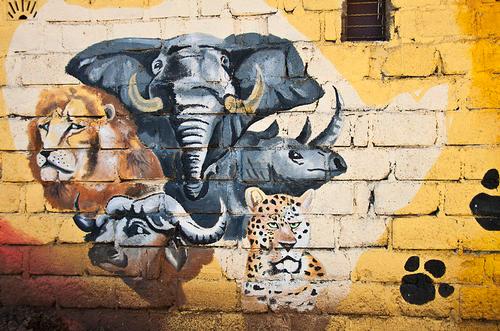 Griffity Image of the Big Five, found in South AfricaPhoto: Vasylysk CC 3.0 Unported no changes made
Griffity Image of the Big Five, found in South AfricaPhoto: Vasylysk CC 3.0 Unported no changes made
Sources
Dekker, M. / Zuid-Afrika
Gottmer/Becht
Luirink, B. / Zuid-Afrika : mensen, politiek, economie, cultuur, milieu
Koninklijk Instituut voor de Tropen,
Moerkamp, J. / Zuid-Afrika
ANWB
Schaap, D. / Zuid-Afrika
Minbuza Kosmos-Z&K
Zuid-Afrika
Cambium
CIA - World Factbook
BBC - Country Profiles
Last updated June 2025Copyright: Team The World of Info